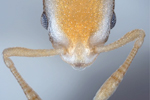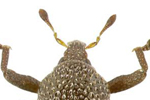Recent expeditions by the Chinese Academy of Science’s Institute of Zoology to the Yunnan Province of China have uncovered the existence of a new species of long-horned beetle. This newly discovered beetle has a beautifully colored blue-green body with short, slender, and distinctively blue legs according to a new article in Zookeys.
There are over 20,000 known species of long-horned beetles. The family, called Cerambycidae, can be distinguished by their extremely long antennae, which tend to be even longer than the beetles’ body. The Cerambycidae family is mostly identified with leaf-litter habitats. Some beetles are considered pests due to the fact that their wood-feeding larvae can cause extreme damage to trees and lumber.
Scientists have given the new species the name Schwarserium yunnanum, which is derived from the location where the species was discovered, the Yunnan Province of China. Yunnan is China’s most biodiverse province. Most of this province lies within either the subtropical highland or humid subtropical zones with mild to warm winters and tempered summers. Its mountainous nature and plenty of precipitation nurture an extremely high level of biodiversity as well as high degrees of endemism, meaning many organisms unique to this specific region.
As a result of this study, the existence of a new subgenus, called Rugosochroma, was also uncovered.

Schwarzerium yunnanum the newly described species: The male beetle is on the left and the female on the right. Photo by Mei-ying Lin.
CITATION: Vives E, Lin M-Y (2013) One new and seven newly recorded Callichromatini species from China (Coleoptera, Cerambycidae, Cerambycinae). ZooKeys 275: 67–75, doi: 10.3897/zookeys.275.4576
Related articles
Newly discovered pirate ant uses sickle-shaped mandibles to decimate rivals

(06/21/2013) A new species of ant has recently been discovered in the Hortarium of the Los Baños University in the Philippines. Scientists named it the pirate ant (Cardiocondyla pirata) due to the female’s unique pigmentation pattern: a distinctive stripe across the eyes that resembles a pirates’ eye-patch. The pirate ant belongs to a genus Cardiocondyla that are distributed worldwide, but mainly found in the tropics.
Scientists describe over 100 new beetles from New Guinea

(06/03/2013) In a single paper, a team of researchers have succinctly described 101 new species of weevils from New Guinea, more than doubling the known species in the beetle genus, Trigonopterus. Since describing new species is hugely laborious and time-intensive, the researchers turned to a new method of species description known as ‘turbo-taxonomy,’ which employs a mix of DNA-sequencing and taxonomic expertise to describe species more rapidly.
New insect discovered in Brazil, only third known in its bizarre family (photos)

(04/15/2013) A new species of forcepfly named Austromerope brasiliensis, was recently discovered in Brazil and described in the open access journal Zoo Keys. This is the first discovery of forcepfly in the Neotropics and only the third known worldwide. The forcepfly, often called the earwigfly because the male genital forceps closely resemble the cerci of the common earwig, remains a scientific enigma due to the lack of information on the family.